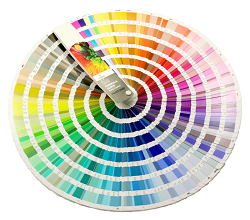Why Pantone Colours Don't Always Match

The use of Pantone Guides as a colour reference chart is common in many industries today. The guides form part of the Pantone Matching System (PMS), developed by an American company that defines a unique reference for each colour listed. This allows different companies from around the world to print or colour their products and materials to a specific Pantone reference.
A classic example of Pantone colour matching uses the four-colour print process known as CMYK. This uses cyan, magenta, yellow and black in different mixtures to produce a specific colour or Pantone reference. The Pantone reference guides also include spot colours and a coating.
You can imagine that Pantone guides have helped many industries including design, manufacturing, advertising, marketing and our very own promotional merchandise industry.
Using Pantones For Promotional Goods
When you have your logo designed by an advertising or marketing agency they will present you with various concepts. From these you will work your way down to a single logo that encapsulates all that you want it to as logo. As part of this process the agency will typically show you a range of materials and how the logo would look including a website screen, literature and printed materials including paper, business cards and with compliment slips.
Once you have finalised your choice down to one final concept logo, this may be ‘tweaked’ slightly and a final version produced. The marketing agency may then provide you with printed copies of everyday documents and business cards as part of the project, together with a corporate image guide.
The corporate image guide is very important. This is a guide that will help you achieve consistency whenever and wherever your logo may be used. The guide should include what we refer to as artwork. This is a layout of the logo showing any colour layers and defining the Pantone colours used.
Sometimes marketing agencies only provide an artwork file. This can be a Photoshop rasterised file or a vector file in a .PDF or Indesign file. What’s important here is that provided a promotional marketing company like Redbows can open the file in Photoshop or Indesign, we can then use the eye dropper tool to click on any part of the logo to find out its colour reference whether this is Pantone, CMYK or RGB (if only a screen version is provided). Once we know the colours we can then look to match up with the right promotional goods.
Choosing Pantone Matching Products
The next part of the process is to choose whether to selecting complimentary or contrasting coloured products. In the promotional merchandising industry we can Pantone match some products. Some may be completely matched or we can find products that provide a neutral colour to print on but with Pantone matched trims. Pens are a classic example where the barrel could be white but with a colour matched pen clip and grip. Where this is not possible it may be necessary to look at a neutral or contrasting colour as a background.
Light and Material Differences
Even when Pantone matched there can still be shading differences and to uncover why it is important to consider the material the product we applying the logo imprint to and how this interacts with light.
When we see a colour what we are viewing through our eye is a light reflection of certain wavelengths which is then processed by our brains. This is why the same image or colour can appear different to two or more different people. We each have our own perception of how we see colours.
Secondly, product materials can be different. Matt and Gloss finished are obvious examples as they will reflect light differently. Smooth and textured finishes will also different in their light reflection and therefore could show colour contrasts. The material could be a woven fabric as in the case of clothing or a sustainable eco material like bamboo or wood. Thirdly the print process could be different for the different goods. Here the clothing may have an embroidered logo or screen printed, a CMYK four-colour process or a spot colour.
The point is that colour variations can be ‘seen’ due to light reflections, how our brains process colours, the materials we are printing onto and the logo imprint process. So how do you achieve a balance?
The first and probably most cost-efficient way to achieve consistency is to choose common materials to apply the imprint to. As soon as you mix materials there is a risk of a colour variation being seen. Some colours are also more notorious for this and certain blues and purples are more known for problems in this area.
The other solution can be a bit more trial an error. Based on experience or a first off sample, the Pantone reference may be changed to get a consistency across the range of goods. This could well mean, where promotional goods have been supplied by another company, comparing the colour of that product to a Pantone reference guide and the person doing the comparing having a very good eye for this level of detail as well as experience of print processes.
The Future For Colour Proofing
Today it is very common to be provided with a black and white artwork sign off form which references the imprint position and Pantone or colour makeup of the imprint on a particular promotional item. This is how the industry has worked for years.
Technology is moving on now to allow 3D electronic samples but again with a black and white sign off form. With IT monitor, laptop, tablet and mobile screen technologies improving at such a rapid rate it is not beyond the imagination that in near future artwork sign-off will be electronic and ‘on-screen’.
Where the technology has to really improve is in the renderings shown. In order to show any colour variations between products on screen it will be necessary to achieve CAD (Computer Aided Design) type quality rendering. CAD is a process of drawing used in engineering from which manufacturing drawings can be generated and it is a process that demands high-end computing power.
If our industry can get to a level where it is possible to provide CAD quality images to clients then on-screen sign-off is not only possible but the image should also be a 100% match to the final goods. When multiple goods are ordered, it will be important to view artwork for all the goods ordered on a screen at the same time and to be able to rotate and see these all in the same light.
Of course one final obstacle remains; the material background which will always result in imprint differences no matter whether a Pantone colour is matched or not. Perhaps experience and an eye for detail is one thing that IT will never be able to replace in our industry, at least not yet.













